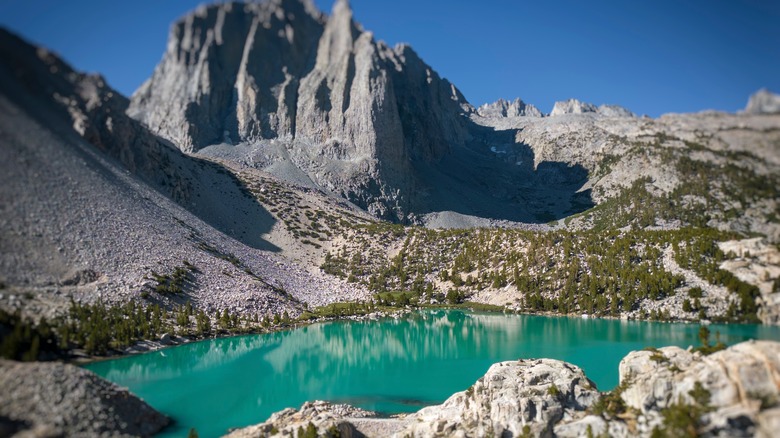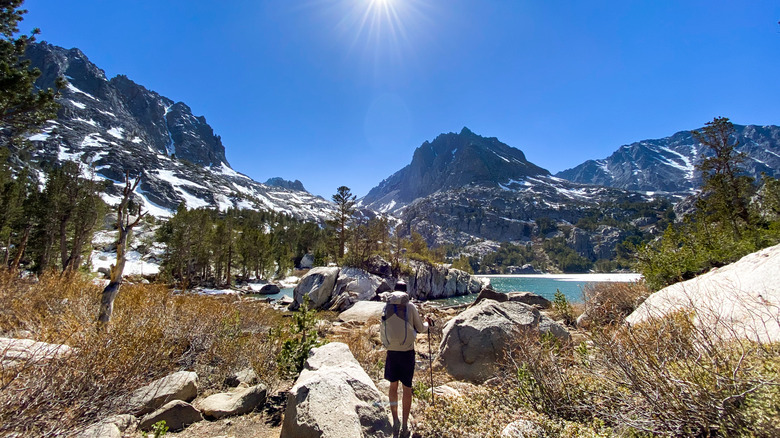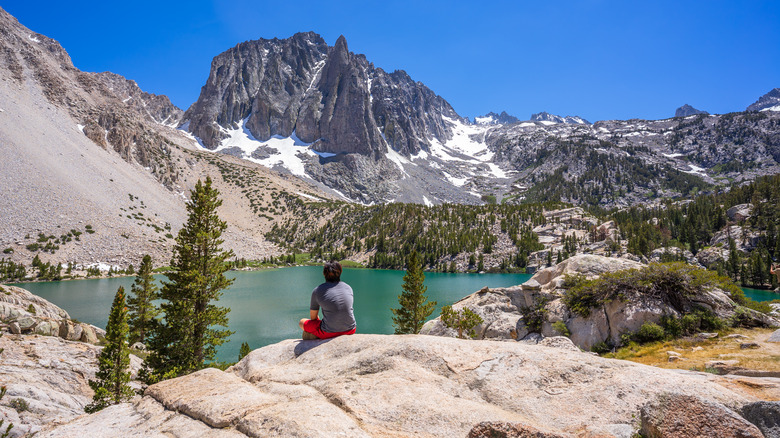The 'Patagonia Of California' Is A Mountainous Gem With Scenic Lakes And Hiking Trails
California is one of those states brimming with outdoor activities, seemingly at every turn. From the beauty of the Pacific Ocean, the hilly mountain tops in Mammoth, or the long stretch of open road leading towards one of California's desert towns, there doesn't seem like enough time to experience it all. And speaking of which, if you happen to find yourself in California and think to yourself, "man, I wish I could explore Patagonia, but I just don't have the time" — fear not! For nestled in the Sierra Nevadas in the John Muir Wilderness sits the unofficially named "Patagonia of California", otherwise known as the Big Pine Lakes Region.
This stunning high-elevation area of the Eastern Sierra is home to vibrant glacial lakes, towering granite peaks, sweeping alpine meadows, and a lot of jaw-dropping scenery that rivals any South American postcard. Despite its growing popularity among adventurers and photographers, the area still manages to feel like a hidden gem, quietly tucked away about a five-hour drive from Los Angeles, waiting to surprise those who make the journey.
And while Patagonia might require international flights and weeks of travel planning, Big Pine Lakes offers something more accessible — yet just as striking. Many hikers come here and find themselves completely caught off guard by just how otherworldly the landscape feels: crystal-clear lakes fed by ancient glaciers, craggy peaks that catch the light at sunset in breathtaking hues, and trails that weave through one of the most pristine slices of wilderness in the entire state. Whether you're a seasoned backpacker looking to summit 14,000-footers, a day hiker wanting a challenge with a serious reward, or a nature lover who wants to sit lakeside and take in turquoise-colored water, Big Pine Lakes offers a little something for every category.
Exploring Big Pine Lakes
There are multiple hiking options in the Big Pine Lakes area, ranging from strenuous day hikes to multi-day backpacking trips, though multi-day trips do require a permit, which is highly recommended to book far in advance. The region is best known for the Big Pine Lakes North Fork Trail, which branches into a network of trails that lead to seven lakes and beyond. Beginning at the Big Pine Creek Campground, this hike winds its way along a 15-mile loop trail, ascending through aspen groves, high-alpine scenery, and past waterfalls. The trail is well-maintained, but the climb can be strenuous due to elevation. The entire loop takes an estimated 8 hours to complete, and although it's difficult, those who have done it say it's "amazing" and "the most beautiful hike (they've) done in California".
Lakes one through three along the trail are the most famous of the seven, and their electric blue-green coloring (caused by glacial silt from the Palisade Glacier) is truly a sight to behold. If you're feeling ambitious, you can push onward to lakes four through seven, which are less visited and feel more remote. Luckily, the weather in California is pretty much nice year-round, even in the mountainsJune is a great time to visit, as snowmelt feeds the lakes, making them extra vibrant, though climbers may experience snow at higher elevations.
July and August are the best times to visit for those looking to enjoy ideal hiking conditions, fewer mosquitoes than in June (during a dry year), great visibility, and warmer lake temperatures. However, the days get hot, so it's best to begin your hike early. September brings fewer crowds but still beautiful weather, and October brings vibrant fall colors, though it's when temperatures begin to drop.
Spending the night
If you're planning a trip to the Big Pine Lakes Region, securing a place to spend the night is an essential part of the adventure — especially since this area has become increasingly popular with hikers, photographers, and outdoor lovers. Whether you're hoping to camp under the stars or simply need a convenient place to crash before or after your hike, there are several options to suit different travel styles and backup plans in case campsites are full.
The most convenient campground for Big Pine Lakes hikers is Big Pine Creek Campgrounds, which sits closest to the trailhead. However, its proximity and popularity mean that it fills up fast, especially on summer weekends and holidays. Upper Sage Flat and Lower Sage Flat Campgrounds, while around four to six miles from the trailhead, offer a good alternative if Big Pine Creek is full. If you plan on backpacking, with your wilderness permit, you can spend the night on the trail at designated backcountry spots. These spots offer solitude, unbeatable views, and crisp alpine air.
You'll need to bring a bear canister, follow Leave No Trace principles, be prepared for changing weather, and bring mosquito protection. If you are unable to secure a campsite, the nearby small town of Bishop has a few lodging options, including hotels, motels, hostels, and cabins. The drive from Bishop to the Big Pine Lakes Campground takes about 30 minutes. Whether you're a bucket list adventurer or looking for your next beautiful weekend escape, Big Pine Lakes delivers the kind of scenery that sticks with you for life. The effort it takes to get there — the drive, the climb, the altitude — all melt away when you round the final bend and see that electric glacial lake shimmering in the sunlight.


